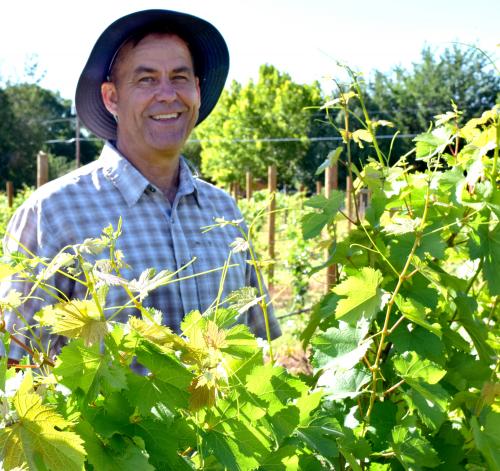New vineyard on display during field day at NMSU Ag Science Center at Los Lunas

Visitors at the center’s field day on Thursday, Aug. 15, will view a three-quarter-acre vineyard containing 800 grapevines in their second season of growth.
Field day registration begins at 7:30 a.m. with tours of the farm beginning at 9 a.m. Following the tours, a free lunch will be served.
“We have several trials going on in the vineyard,” said Gill Giese, NMSU Extension viticulturist who is conducting the various studies. “There are a total of 12 cultivars being studied.”
Six Vitis vinifera cultivars on three different trellis systems are being studied for ways of managing the canopy to optimize impact on water use and grape quality.
“Because water is an issue throughout semi-arid New Mexico, we want to find the most efficient way to raise grapes for our expanding wine industry,” Giese said.
Another trial is being conducted with the red French-American hybrid Chambourcin variety, which has been grown by a substantial number of New Mexico winegrowers.
“This is a straightforward trial to compare own rooted Chambourcin against those grafted to a root stock,” Giese said. “We want to determine if there is a benefit by grafting and determine the appropriate crop load for New Mexico conditions.”
Giese is also evaluating the native grape Vitis aestivalis, a red grape native throughout the eastern United States out to Oklahoma and south to Texas. It is known as “Norton” or “Cynthiana” and is the state grape of Missouri.
“New Mexico growers are experimenting with this variety and have had success in the middle Rio Grande Valley,” Giese said. “We want to quantify tonnage per acre, optimal flavor, aroma and color for our state’s winegrowers.”
The last two wine grape cultivars are Arkansas hybrids called “Enchantment” and “Opportunity.” These have proven hardy in other regions and Giese wants to evaluate them under New Mexico conditions.
Visitors will notice a difference in the vineyard floor compared to traditional vineyards that typically have bare soil.
“We are establishing ground cover of grasses native to the western U.S.,” Giese said. “We want to see if we can maintain a ground cover to improve or maintain soil health, mitigate erosion, support native pollinators and optimize vine overall performance.”
The 200-acre agriculture experimental farm is shared by NMSU’s College of Agricultural, Consumer and Environmental Sciences and the U.S. Department of Agriculture’s Natural Resource Conservation Service plant center.
At the farm, researchers conduct studies on agronomics and horticulture crops, and sustainable farming practices for the middle Rio Grande Valley, central New Mexico and the Southwest.
Some of the work will be reported on during the field trip, including:
- Creating pollinator habitat with native plants
- Healthy soils, healthy you - mineral depletion of our food, how many servings of vegetables are enough.
- Alfalfa and pasture research program
- Predicting crop drought stress in the field with above and below ground monitoring
- Sustainable bio-economy for arid regions – prospects of growing guar in Valencia County
- Removing sand burr seeds with recycled burlap
- Weed management in chile production
- Utilizing cover crops for soil improvement and weed management
- Jujube fruit production
- Brassicaceae biofumigation for weeds and soil-borne diseases in chile peppers


